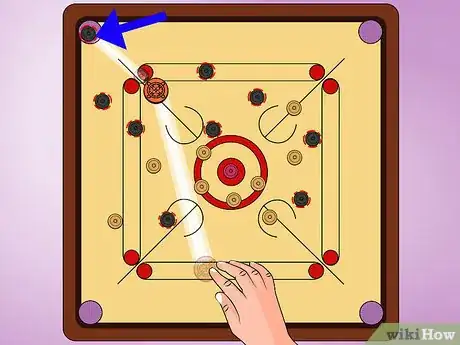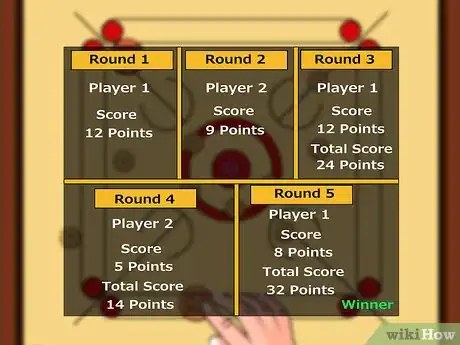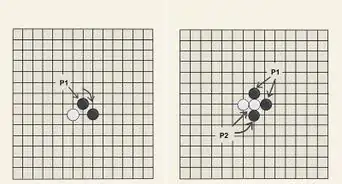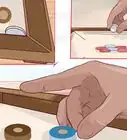This article was co-authored by wikiHow Staff. Our trained team of editors and researchers validate articles for accuracy and comprehensiveness. wikiHow's Content Management Team carefully monitors the work from our editorial staff to ensure that each article is backed by trusted research and meets our high quality standards.
wikiHow marks an article as reader-approved once it receives enough positive feedback. This article received 18 testimonials and 83% of readers who voted found it helpful, earning it our reader-approved status.
This article has been viewed 663,461 times.
Learn more...
Carrom is an interesting game similar to Billiards or Table Shuffleboard. However, instead of pool cues, you use your fingers and a striker. The game can be played by either two people (singles) or four people (doubles). The game is also known by other names around the world, including carrom, couronne, carum, karam, karom, karum, and finger billiards.
Steps
Setting Up the Board
-
1Familiarize yourself with the symbols on the board. Think of Carrom as a game of finger billiards. Instead of balls, you use small playing pieces and try to put them in pockets with a heavier piece called a striker. A Carrom board is a large wooden board that contains a variety of markings. Make sure you know the meaning of these markings before you begin to set up the game to play. It's vital to understand the board in order to play carrom effectively.[1]
- The Carrom board should be positioned 60-70 centimeters (roughly 23 to 28 inches) above the ground.[2]
- A circular hole sits in each of the board's four corners, and a net is placed under each hole to catch the pieces.[3] There are two foul lines on the board, and two concentric circles stand in the board's center. The center circle is the size of a playing piece, and the main circle is six times larger. Before beginning the game, the pieces are arranged in these circles.
- There are also rectangles drawn on either side of the board. Each player has his or her own rectangle, and must shoot their strikers from these rectangles.
-
2Learn the significance of carrom pieces. There are 9 black pieces in carrom, 9 white pieces, and one red piece (sometimes referred to as "the queen"), in addition to two pieces known as the "striker pieces." Each player has 9 pieces in Carrom, in addition to one striker piece. One player has all black pieces, and the other player has all white pieces. Sometimes, the pieces are referred to as carrommen.[4]
- The white and black pieces are smooth, wooden pieces that look something like the ones used for the game checkers. In each round, you attempt to use your striker to knock these pieces into the board's pockets.
- The red piece is called the queen, and it can be pocketed any time you want after sinking your first piece (the queen's function is similar to the black 8 ball in Billiards). If you have less than 24 points, the queen will add an additional 5 points to your score. If you have more than 24 points, you receive no additional points for pocketing the queen.
Advertisement -
3Set the board up for play. To start the game, put the queen in the board's center. Then, put six pieces around the queen directly in a circle. Each of those six pieces should touch the queen and its neighboring piece.[5]
- Position the remaining 12 pieces around the inner circle of six pieces. Make sure each outer piece must touch the inner circle. Alternate the color of the pieces. In other words, the circle should have one red piece, followed by a white piece, followed by a red piece, and so on.
- You and your opponent should place your strikers in the rectangular boundaries on either end of the board.
Beginning the Game
-
1Sit opposite from each other. The game is often played as singles with two opponents, although sometimes people play Carrom in teams. At any rate, teams or players should sit opposite from one another. You and your partner, or your team and your partner's team, should take a seat at opposite ends of the board. You should each have your own rectangle from which to shoot your striker.[6]
-
2Practice gripping your striker. The striker is the heavier piece you use to hit your pieces into the pockets. If you're new to the game, it's a good idea to practice gripping and hitting the striker a few times before playing. Make sure you flick the striker instead of pushing it. You cannot move or leave your chair when using the striker, and you have to hit the striker from within the rectangular boundary on your end of the board. There are two main grips you can use to hit the striker: the straight grip and the scissors grip.[7]
- The most commonly used grip is the straight grip. It may be easier to maneuver if you're new to carrom. You hold your hand palm side down and rest your fingertips very lightly on the carrom board. You would hold your index finger just behind the piece and make your shot by flicking your finger. For added control, hold the striker between your thumb and third finger to position it before flicking it.
- The scissors shot is less commonly used, but you may find it more comfortable. You would place your hand sideways on the board, so your ring and pinky finger are pressed on the board. You would then hold your middle finger backwards with your index finger, so these two fingers are at a roughly perpendicular angle with your pinky and ring finger. It looks somewhat like a pair of scissors. A shot is made by releasing your middle finger, causing it to snap forward and hit the striker.
-
3Determine who goes first and have that player break the circle. Usually, a coin flip is used to determine who goes first, but there are no strict rules. If you'd rather not do a coin flip, you can follow rules of other board games, such as "the oldest player goes first" or "the tallest player goes first." Once you've determined who goes first, that player has to break the circle in the middle by taking the first shot with his or her striker.[8]
- It's unlikely any player will get a piece in the pocket on the first shot. In the event this occurs, however, that player will continue to take turns until he or she fails to pocket a piece.
- You must always return your striker to your rectangle before taking a new shot.
-
4Take turns until you determine who pockets which colors. You do not go into a game of carrom knowing whose pieces are black and whose are white. This is determined in play. The first player to pocket a piece must pocket pieces in that color for the rest of the game.
- The object of carrom is to get all your pieces pocketed before you opponent does. You should also aim to pocket the red piece, sometimes referred to as the queen.
- The red piece, or queen, can only be pocketed after you've pocketed a piece of your color.
Completing the Game
-
1Continue playing until the conclusion of the first round. A round of carrom ends when one player pockets all of his or her pieces, and the queen has been pocketed. You play rounds until one player has reached 29 points. The first player to hit 29 points wins.[9]
- Remember, you and your opponent take turns shooting your striker. You can only shoot your striker from within your rectangular boundary.
- In the event you pocket a piece, you get to continue to play. You can shoot your striker again, and can continue to shoot your striker until you fail to pocket a piece.
-
2Follow rules regarding the queen. The queen, or red piece, has to be pocketed by the end of a round. A player must both pocket and "cover" the queen. Covering the queen simply means one player has pocketed the queen following the rules of the game. Under certain circumstances, you can pocket the queen but not "cover" it, and the queen will be returned to the board.[10]
- You cannot pocket the queen until you've pocketed at least one piece in your color. In the event you pocket the queen before pocketing any pieces, you have not covered the queen. The queen will be returned to the center of the board.
- If you pocket the queen after pocketing one of your own pieces, you have successfully covered the queen. The queen will not be returned to the board and you may receive points for the queen at the conclusion of the round.
-
3Penalize players for fouls. There are fouls in the game of carrom. In the event you or your opponent commits a foul, you are penalized by having one of the pieces in your color returned to the board. The following situations can result in a foul:[11]
- If you accidentally pocket a striker, this is a foul. You will also receive a foul if you knock your striker or another piece off the board.
- If you pocket an opponent's piece, this is a foul. In addition to having one of your pieces returned to the board, pocketing an opponent's piece comes with an additional penalty. If you pocketed and covered the queen earlier in the game, the queen is also returned to the board.
- If you pocket your final piece before the queen has been pocketed, both the piece you pocketed and the penalty piece are returned to the board. In other words, two pieces are returned to the board in this case.
- If you touch any piece besides your striker, this is a foul.
-
4Continue playing a round until one player has pocketed all of his or her pieces. The first player to pocket their pieces wins the round, and is then awarded points. However, a round cannot end with the queen still on the board. The queen must have been pocketed and covered by one player for the round to conclude.
-
5Score each round properly. To determine your score, count how many pieces your opponent still has on the board. For example, say your opponent has 5 pieces remaining on the board. Your score would be 5.[12]
- If you pocketed and covered the queen during the game, an additional 5 points are added to your score as long as your score is below 24. If you had 5 points based on your opponent's pieces, and you covered the queen, your score for the round is 10.
- Points add up as you continue to win rounds. Once you reach 24 points total, you no longer get the additional 5 points for covering the queen.
-
6Complete the game. There is no set number of rounds you play in carrom. You simply play until a player hits 29 points. You add up scores from each round. Eventually, someone should hit 29 points or higher, allowing the game to end.[13]
- For example, you score 12 points in the first round. Your opponent wins the next round, scoring 9 points. In the following round, you score 12 points again, giving you a score of 24.
- In the fourth round, your opponent wins and scores 5 points, giving him or her a total score of 14 points. In the fifth round, you score 8 points. You have a score of 32, exceeding the 29 points you need to win. You have won this game of carrom.
Community Q&A
-
QuestionWhat happens when the stdiker falls into netholes?
 Community AnswerThis is a foul. One of your pieces will be returned to the board as a penalty.
Community AnswerThis is a foul. One of your pieces will be returned to the board as a penalty. -
QuestionIf I pot two pieces in one stroke, do I get two more turns, or just one?
 Community AnswerYou will only receive one additional turn.
Community AnswerYou will only receive one additional turn. -
QuestionWhat happens if the striker goes into a pocket? Or, if the striker follows a card on into a pocket?
 Community AnswerIf the striker goes into a pocket, the already pocketed piece is placed back on the board anywhere in the central circle by the opponent.
Community AnswerIf the striker goes into a pocket, the already pocketed piece is placed back on the board anywhere in the central circle by the opponent.
References
- ↑ http://theplanetd.com/learning-to-play-carrom-a-popular-game-in-india/
- ↑ http://www.carrom.co.uk/
- ↑ http://www.mastersgames.com/rules/carrom-rules.htm
- ↑ https://www.getmega.com/casual/carrom/learn/basic-carrom-rules-for-beginners/
- ↑ http://www.mastersgames.com/rules/carrom-rules.htm
- ↑ http://www.mastersgames.com/rules/carrom-rules.htm
- ↑ http://www.carrom.org/players/
- ↑ https://carrom.com/wp-content/uploads/2015/08/Carrom-Game-Board-Rulebook.pdf
- ↑ http://www.mastersgames.com/rules/carrom-rules.htm
About This Article
If you’re a beginner playing Carrom, start by thinking of the game as finger billiards, and getting familiar with the symbols on the board. You also need to understand the function of the 9 black and 9 white playing pieces, 2 striker pieces, and red queen, which acts like the black 8-ball in billiards. When you play, use your striker piece to hit your other pieces into the game board pockets by flicking it. To win, try to get the queen and all of your own pieces pocketed before your opponent does. For more on playing Carrom as a beginner, including scoring each round, keep reading!












































































